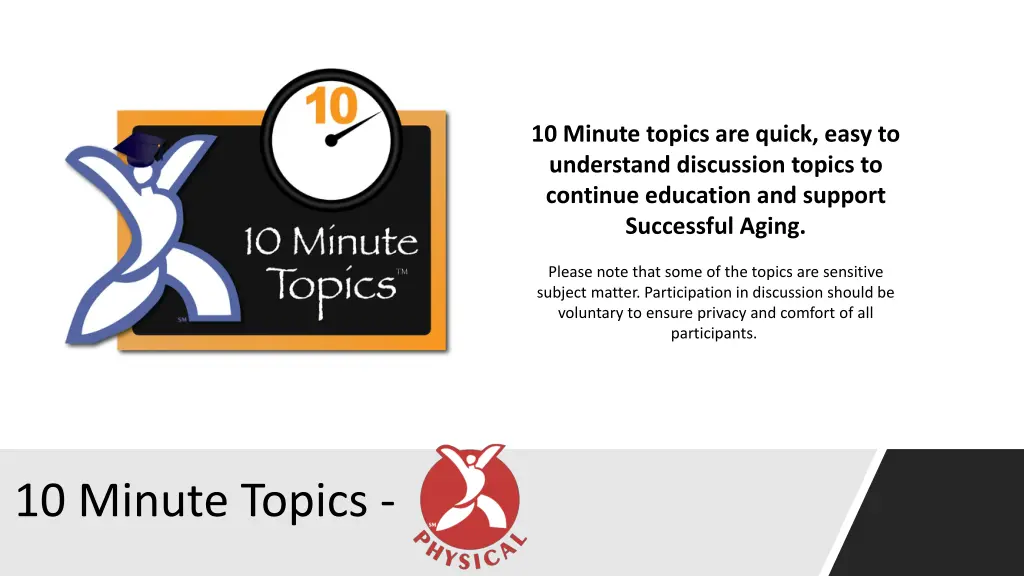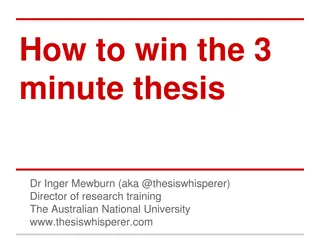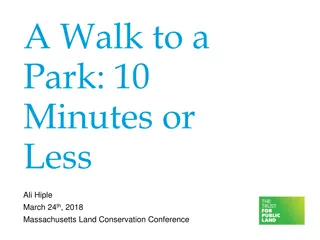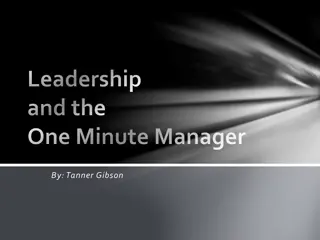
Supporting Healthy Aging: Discussion on Health Risks, Sensory Changes, Walking, and Life Expectancy
Explore important topics related to successful aging, including managing health risks, supporting sensory changes during dining, reaping the benefits of walking for physical and mental health, and understanding life expectancy trends. Engage in insightful discussions and share experiences on these key aspects of aging well.
Download Presentation

Please find below an Image/Link to download the presentation.
The content on the website is provided AS IS for your information and personal use only. It may not be sold, licensed, or shared on other websites without obtaining consent from the author. If you encounter any issues during the download, it is possible that the publisher has removed the file from their server.
You are allowed to download the files provided on this website for personal or commercial use, subject to the condition that they are used lawfully. All files are the property of their respective owners.
The content on the website is provided AS IS for your information and personal use only. It may not be sold, licensed, or shared on other websites without obtaining consent from the author.
E N D
Presentation Transcript
10 Minute topics are quick, easy to understand discussion topics to continue education and support Successful Aging. Please note that some of the topics are sensitive subject matter. Participation in discussion should be voluntary to ensure privacy and comfort of all participants. 10 Minute Topics -
Health Risks Sometimes we can be at risk for certain illnesses even if our lifestyle is very healthy. Factors that we cannot control may be to blame for putting us at risk, such as age, gender, race, or genetics. If you have a condition that runs in the family, there is a chance that you could be at a high risk for getting that condition. The best way to deal with this is to live a healthy lifestyle and be aware and educated about the condition. Schedule regular checkups with your doctor so that together you can monitor the situation carefully, and take advantage of preventative screening. Early detection is crucial. ____________________________________________________ Discussion Questions: What are some health conditions that run in your family? How have you managed your risks? What are some of the ways our community supports you in managing your health risks?
Sensory Changes and Dining Older adults can experience sensory changes as they age. These changes can impact various areas of life, including mealtimes. The most common sensory changes experienced are in vision and hearing. These changes can impact the ability to participate in mealtime conversations. Vision impairment can also impact the visual appeal of the food a person is eating. On average, the senses of touch and smell do not change a great deal with age. However, some medications can interfere with the sense of taste or other senses. Be sure to check with your doctor about possible side effects from medication. Today, there are many tools and equipment available to assist older adults experiencing sensory changes such as hearing aids and glasses. ____________________________________________________ Discussion Questions: How can we support people experiencing sensory changes impacting their dining experience? Have you experienced any changes? If so, how have those changes affected you?
Walking Walking is one of the simplest forms of physical activity that can be done anywhere, with anyone, and without cost. Walking is a simple activity that has important health benefits. Research shows that older adults who participate in regular walking increase muscle strength and improve their physical and mental health status. Walking has proven to improve flexibility and balance and decrease the risk of chronic disease. One way to get a routine going is to start a walking club in your community and invite others to join. ____________________________________________________ Discussion Questions: What are the benefits of walking? How can you get more walking in during your day? What are some of the barriers that prevent or discourage you from walking more?
Life Expectancy Did you know that the average person will live to be about 78 years old? In 1900, the life expectancy for the average person was only 47 years. The reason for this dramatic increase is due to public health, nutrition and medicine. Doing things like washing our hands, eating a better diet, staying physically active and taking appropriate medications can help keep us healthy. We are all capable of doing these things and taking responsibility for our own health and nutrition, so in a way we control how long we can expect to live. _______________________________________________ Discussion Questions: What historical events can you think of that may have contributed to this dramatic increase in life expectancy? (Polio Vaccine 1952, Penicillin 1928, etc.) What impact might this increase in life expectancy have on our society? What advice do you have for younger people to help them live a long, healthy life?
Strength The benefits that come with strength training are plentiful for older adults! Research has shown that older adults, at any age, can increase muscle strength and size. Engaging in regular strength training can be very powerful in reducing the signs and symptoms of many diseases and chronic conditions including: arthritis, diabetes, osteoporosis, obesity, lower back pain, and sarcopenia (age related muscle loss). Not only do the benefits apply to the physical body, but they also extend to improving brain performance. __________________________________________________ Discussion Questions: How could you benefit from becoming stronger? How can you share what you have learned about strength with others? What types of activities are offered at your community that include strengthening the muscles?
The Lifestyle Review The Lifestyle Review looks at whole-person wellness. It takes a snap-shot of physical, intellectual, social and spiritual activities. It was designed by the Masterpiece Living advisory board to provide people with feedback about their successful aging endeavors. This process is different for each person. The report for the Lifestyle review highlights strengths and opportunities in the four areas of wellness. __________________________________________________ Discussion Questions: How do you ensure that you are reaching balance in your life? What are the benefits of taking the lifestyle review? How can we get the word out about the lifestyle review so that they can take advantage of this resource? (Facilitator note: have copies of the Lifestyle Review available to look through)
Preventing Chronic Disease Heart disease, cancer, stroke, certain lung diseases and diabetes are the leading causes of death in the world. They are called chronic diseases. In 2009, 7 out of 10 deaths in the U.S. were due to chronic diseases. More than 75% of fall health care costs are due to chronic conditions. Out of the 35 million people who died of chronic diseases in 2005, half were under the age of 70 and half were women. A Masterpiece lifestyle can help you avoid chronic disease and live a long, healthy life. Cheap and simple ways to live a healthy lifestyle that can prevent chronic disease includes a healthy diet, physical activity, avoiding too much alcohol, and quitting smoking. _______________________________________________ Discussion Questions: What are some things that you are currently doing to prevent chronic disease? What is one thing that you can add to your lifestyle that would help to combat chronic disease? What does a healthy lifestyle look like to you?
Walking Safety Injuries can happen while walking if proper gear and safety measures are not used. The Mayo Clinic recommends wearing comfortable shoes that are cushioned and have good arch support. There are specific shoes designed for walkers which can help prevent blisters and calluses. Also, when walking outdoors, it is important to wear bright colors so you are visible to motorists. This becomes even more important after dark. _______________________________________________ Discussion Questions: What else do you think is important for walking safety? What type of footwear do you recommend for walking safety? For more information about proper footwear visit: http://www.mayoclinic.com/health/walking/HQ00885_D
Yoga Yoga can have many health benefits. Beyond physical health, yoga can improve the mind, body and spirit of those who participate. Among the many benefits are improved sleep, increased strength, relief of arthritis, relief from chronic pain, and improved mood. __________________________________________________ Discussion Questions: Have you ever tried yoga? If so, what have you found to be the benefits? What are some things you can do to encourage others to attend yoga classes?
Walking Technique and Posture Proper walking technique is important. This may seem obvious but posture, warm up and cool down are all important in preventing injury. Let s try walking with proper posture together. Facilitator: Have everyone try using proper posture while walking. About.com provides the following steps: Stand up straight. Think of being a tall and straight. Do not arch your back. Do not lean forward or lean back. Leaning puts strain on the back muscles. Eyes forward, not looking down. Look 20 feet ahead. Chin up (parallel to the ground). This reduces strain on neck and back. Shrug once and let your shoulders fall and relax. Hold your shoulders slightly back. Suck in your stomach __________________________________________________ Discussion Questions: What makes using proper posture difficult? How can we adapt for these difficulties? How might using proper posture improve your health?
Healthy Weight Maintaining a healthy weight is not an easy task, especially when unhealthy convenience foods are surrounding us. In addition to unhealthy food, there are many energy saving devices such as remote controls and escalators that decrease the amount of exercise we get each day. Being overweight increases the risk of developing diabetes, cancer, gallstones, high blood pressure, heart disease and stroke. The more a person s weight increases, the more at risk they become for these conditions. The bottom line is that if you re overweight, it s worth trying to lose some weight to decrease your risk for many health conditions. ________________________________________________ Discussion Questions: How do you work towards maintaining a healthy weight? What are the most difficult things about maintaining a healthy weight? How can our community help support you to maintain a healthy weight?
Expectations "The biggest contributor to premature disability is physical inactivity. The biggest contributor to physical inactivity is low expectations." Spirduso __________________________________________________ Discussion Questions: In what ways are you physically active? In what ways might you increase your physical activity to prevent premature disability? How can you inspire others to prevent disability through increased physical activity?
Flexibility and Stretching Stretching at any age is beneficial for flexibility, and becomes increasingly important as we age. With age, tissue around joints tend to thicken and become tighter and more restricted. Stretching joints, muscles and tendons increases your range of motion for movement in different parts of the body. Benefits of stretching and being flexible include: easier movement, more range of movement, less chances for falling and less joint pain. _______________________________________________ Discussion Questions: What do you do for stretching and flexibility? How have you benefited from stretching and increasing flexibility?
Low Fat vs. Low Calorie Terms used on food labels can get confusing. Two examples of terms are Low Fat and Low Calorie . Low calorie means that there are 40 calories or less per serving. Low fat is referring only to the fat content, not the calorie content. If a box says, low fat , that means it has 3 grams or less of fat. Neither low fat nor low calorie can tell us if the food is a nutritious food overall. We must be especially careful with things labeled low fat because they may be packed with calories. Low calorie foods may be made from artificial products, to be low in calories. Most of our plate should be filled with whole-grains and fruits and vegetables. If we follow this rule, we don t really need to worry about the low-fat/low calorie labeling. _______________________________________________ Discussion Questions: How does learning about the terms low fat and low calorie impact the way you look at packaged snack foods? What are some low calorie or low fat foods that you know are still not healthy?
Walking and Aging The benefits of walking are countless. Two exciting aging related benefits of walking are that it can decrease biological age and can improve memory. What does decreasing biological age mean? It means that, if a person participates in a vigorous walking routine, their number of functional years (years that they are independent) can increase by 12 years.To add to that, a study of 18,000 women showed that those who walked had better memory, learning and attention. These aging specific benefits, combined with the numerous health benefits, make walking a no brainer . Let s get walking! _______________________________________________ Discussion Questions: Walking has so many benefits. What do you see as the benefits? What motivates you to walk? How can our community help support you increasing your time walking?
Trans Fats Trans fats are a group of fats that can be found naturally in meat. For the most part, trans fats are generated during the processing of foods. Trans fats are often used as a preservative to extend the shelf life of packaged foods. While some fats are good for your heart, trans fats are considered bad fat because they are bad for the heart. It is recommended that you avoid foods containing trans fat such as stick margarine, shortenings and hydrogenated vegetable oils found in processed foods and packaged cakes, crackers and cookies. _______________________________________________ Discussion Questions: How does learning about trans fats impact the way you look at packaged snack foods? What other foods do you know of that contain trans fats?
Fall Hazards On average, one in three adults over 65 falls each year. Those who fall are two to three times more likely to fall again. One major cause of falls are environmental hazards. Environmental hazards are ways in which our home or work environment are set up that can be harmful or a risk to us. Some examples of fall hazards are: Poor lighting Trip hazards such as items on the floor, power cords, etc. Slip hazards such as loose rugs, wet or icy surfaces Staircases where most falls occur due to loss of balance or coordination A clear path from the bed to the bathroom is also very important for the evening _______________________________________________ Discussion Questions: How can we prevent fall hazards around the community? How can we help people reduce fall hazards in their homes?
Falls A fall is when a person unintentionally ends up on the ground or floor. Each year 1 out of every 4 adults 65 years or older falls. Older adults are hospitalized for fall related injuries 5X more than other causes and every 11 seconds an older adult is treated in the emergency room for a fall. Studies have shown that exercises (physical component) such as strength training, balance training and aerobic activity can prevent older people from falling. It is also important to consider the social, intellectual and spiritual components of health in addressing fall risk. _______________________________________________ Discussion Questions: Did any of these statistics on falls surprise you? Name a few ways you can address fall risk in the community. What do you do to prevent falls? How can we continue to prevent falls in our community?
Walking Poles Walking poles are designed to improve the walking experience. They can increase confidence and control while walking. They also turn walking into a full body exercise by working your upper body while you walk. Benefits of using poles for mobility include: Improved balance and stability Reduce risk of falling & improve circulation Achieve a more fluid and even walking gait Increase endurance Improves posture & cardio-pulmonary function _______________________________________________ Discussion Questions: Have you ever used walking poles? If so, what benefits have you experienced? Do you find walking easier or more difficult with walking poles?
Aquatic Exercise/Water Aerobics- Part 1 Water aerobics are not always viewed as an exercise for all ages. However, water exercise is a great alternative to exercise on land. The combination of buoyancy and resistance provides an excellent workout. This is especially true for people who have a limitation to exercising on land. Water immersion reduces blood pressure and stress hormones. In addition, immersion strengthens breathing muscles, enhances the efficiency of our hearts, improves kidney function and increases blood circulation to our muscles. ______________________________________________ Discussion Questions: Who has tried water aerobics? If you have, how did you feel after participating? With the many benefits, what do you think stops people from participating?
Aquatic Exercise/Water Aerobics- Part 2 Aquatic exercise is more popular than ever: everyone from athletes to fitness beginners are benefitting from water workouts! Aquatic exercise helps to increase strength, flexibility and endurance, and is safer than other types of exercise. Because there is less gravity in the water, there is less risk of injury. Research has shown that aquatic exercise increases bone density in older women. In short, whether you re an older adult, a competitive athlete, overweight, recovering from injury, pregnant, or dealing with chronic pain, water workouts are a good option to consider! ______________________________________________ Discussion Questions: What opportunities are there in your area for aquatic exercise? What would prevent you from trying an aquatic exercise class? How might you benefit from this type of activity?
Successful Aging Triad According to the book, Successful Aging, there are three things that have shown to contribute to successful aging: 1. Low risk of disease and disability 2. High physical and mental function 3. Active engagement with life, including having a network of friends as well as having meaning and purpose in life _______________________________________________ Discussion Questions: Can you think of someone who takes part in these three categories? What does their lifestyle look like? What about for you? What area are you strongest in? What category can you improve on? How can we promote these three things in our community?
The Mobility Review The Mobility Review measures balance, flexibility, strength and endurance. Even professional athletes measure endurance, speed and strength on a regular basis. It is a good idea to look at strengths and opportunities for improvement in the different areas of physical activity. The Mobility Review helps do this, which is important, so we can continue participating in activities that we enjoy. __________________________________________________ Discussion Questions: What do you do to improve your balance, flexibility and strength? What would you say if someone asked you why the Mobility Review is important? How can we get the word out about the Mobility Review so that our community can take advantage of this valuable resource?
Alzheimers Disease True or False: Every older adult gets Alzheimer s disease (AD) sooner or later? False, research says that 10% of people age 65 and older have AD. The risk gets higher as people age. If AD runs in the family, a person could have up to a 50/50 chance of getting it. Someone with AD not only has memory loss, but problems with speech, behavior, and other brain-related abilities. However, there are things people can do to prevent AD such as physical activity, brain exercises and good nutrition. Researchers are working very hard to find a cure, until then, we must do what we can to prevent AD or delay the symptoms. _______________________________________________ Discussion Questions: What kind of activities does our community offer to help ward off Alzheimer s disease What are some of the activities you engage in on a regular basis that are intellectually stimulating? How can you share what you have learned about Alzheimer s disease? (Brainstorm this question and encourage group members to talk to someone about what they have learned and report back next group meeting.) Facilitator: visit www. www.alz.org for more facts, figures and information
Tai chi Tai chi is a noncompetitive, self-paced system of gentle physical exercise and stretching. Each posture flows into the next without pause, ensuring that your body is in constant motion. When Tai chi is performed, three major components are working together: movement, mediation, and deep breathing. Tai chi offers many health and well-being benefits for older adults, these include increased mindfulness, increased energy levels, better balance and coordination and reduced anxiety/depression. Many people also participate in Tai Chi for spiritual reasons. _______________________________________________ Discussion Questions: Have you ever participated in a Tai Chi class? How can you encourage those in your community to participate in Tai Chi? How can you share what you have learned about Tai Chi with others? Do you think of Tai Chi as more of a physical activity or a spiritual activity?
Aerobic Activity (Facilitator: Begin with this topic with the 30 second Sit to Stand activity from the Mobility Booster. Have participants cross their arms over their chest and count how many times they can go from a seated to standing position in 30 seconds) Can you walk or jog a mile? Walking and jogging are examples of aerobic activities. Research has shown that older adults can remain healthy and live longer independently by maintaining and improving their aerobic fitness. Studies show the benefits of aerobic activity include less risk of heart disease and stroke, control of diabetes, protection from bone loss, lower blood pressure and cholesterol, and better digestive function. Low levels of aerobic activity in older adults indicate a high risk of an early death. Participating in regular physical activity that is challenging is part of the Masterpiece lifestyle. The benefits are more than just physical. As you have probably heard, what s good for the heart is good for the brain! _______________________________________ Discussion Questions: What types of aerobic activities do you do on a regular basis? What benefits have you experienced from aerobic activity? How can you help other group and group increase their aerobic activity? What are your future plans for including aerobic activity in your daily life?
Sex The general stereotype is that older adults become asexual as they move into old age. The topic has become taboo to some extent and with it come some common myths that have been in place for many years. The truth is, seniors are engaging in sexual relations well into their 70 s, 80 s. The research shows that most older adults are sexually active as long as their health holds out. Over half of people age 65 to 74 are sexually active and roughly a quarter of older adults 75-85 are sexually active. The research reaffirms that older adults still do enjoy the positive aspects of intimate relationships and the significance it plays in their lives. _______________________________________ Discussion Questions: What are some barriers in discussing sex? What are some instances that you ve experienced stereotypes of older adults and sex?
Happy Gardening Research shows that gardeners report better life satisfaction, higher energy levels and better self-rated health than their non-gardening counterparts. In addition, gardeners eat more fruits and vegetables, are more physically active and live healthier lifestyles. _______________________________________ Discussion Questions: Experts recommend eating 5 servings of fruits and vegetables each day. How many servings do you normally eat? How might you increase your intake? Grand Lake Gardens, Masterpiece Living community in Oakland, CA, planted a community garden and in their first year raised over 600 pounds of fresh, organic produce that fed 900 hungry older adults. What is possible at your community? April is National Garden Month, and gardening is a healthy pastime, whether a terrarium, a flower pot or a vegetable garden. How might you encourage others in your life, from children to older adults, to learn more about gardening?
Successful Aging Successful Aging is not just the difference between sickness and health, it is about being the best you can be throughout your entire life. _______________________________________ Discussion Questions: What does successful aging mean to you? What about for your family, what would successful aging look like for them? What is your role in promoting successful aging?
Fruits and Vegetables It is recommended that we eat 5 or more servings of fruits and vegetables each day. Specifically, we want to aim for at least 3 vegetable and 2 fruit servings daily. Fruits and vegetables are packed with healthy vitamins and nutrients. To get the maximum benefit, it is recommended to choose fruits and veggies that are bright in color including dark greens, deep reds and vibrant yellows. _______________________________________ Discussion Questions: What is your favorite fruit? Vegetable? What fruit and vegetable offerings do we have on our dining menu? What tips or tricks do you have that help you get the recommended servings?
Mindful Eating Mindfulness is about being present in the moment. Use the exercise below to practice being mindful while eating. Provide the group with a healthy snack, such as a granola bar or piece of fruit. Guide them through the senses as they experience their snack. Sight: Ask the group to look at their treat and notice the colors, textures and the shape of the snack. Hearing & Touch: Ask them to hold and unwrap the snack from the packaging (if any). Guide them to listen to the sounds of the wrapper as they unwrap it. Guide them to notice the weight and textures of the snack. Smell: Ask them to smell the snack and notice the many aromas they can detect. (For example, a granola bar might initially smell of honey and oats. With attention, one might detect aromas of cinnamon or maple as well.) Taste: Now, ask the group to take a bite of their snack. (They will be ready!) Guide them to savor their bite, chew slowly, taste the layers of flavors and notice the textures as they eat. _______________________________________ Discussion Questions: How was the experience of eating your snack in this way? How did it differ from the way we normally eat snacks? How could mindful eating support a successful aging lifestyle?
Stress and Weight Stress can not only indirectly cause a person to gain weight, but it can also prevent a person from losing weight as well. When people are under high amounts of stress they may have the urge to indulge in unhealthy foods or comfort foods . This may be especially true during certain times of the year such as the holidays when traditions can affect both the types of foods we eat and how much. In this way, stress can cause unwanted weight gain. Additionally, a person under high levels of stress may find it harder to lose weight. As stress levels increase, a chemical called cortisol is released within the body, which aids in fat storage and makes it more difficult for a person to lose weight. A person under high levels of stress and seeking to lose weight should consider adding stress management techniques to their plan. _______________________________________ Discussion Questions: Are there periods during the year that elevate your levels of stress and cause comfort eating? What are some ways you can combat comfort eating caused by stress? What are some ways or techniques you can use to effectively manage your stress?
Physical Activity and Dementia Exercise has many incredible impacts on our health. A recent study found that people who reported engaging in moderate to heavy levels of physical activity had about a 40% lower risk of developing any type of dementia.How you spend your time today truly impacts your future. _______________________________________ Discussion Questions: How can you increase your physical activity today? How might you encourage others to become more physically active? What opportunities exist for physical activity at our community? Perhaps you d like to try something new. What prevents you from doing so?
Cataracts You may have heard of the term cataracts before. This could be because more than half of people over age 80 have had or currently have a cataract. What are cataracts? They are a clouding of the eye and this clouding affects vision. Common symptoms of a cataract are: blurry vision, faded colors, poor night vision, double vision and seeing a glare. The risk of cataract increases as you age. Other factors such as smoking and alcohol use, excessive exposure to sunlight and some diseases such as diabetes can put person at higher risk. The good news is that corrective surgery improves the condition for most people. _______________________________________ Discussion Questions: How might cataracts impact a person s day to day life? What vision impairment resources are available at our community?
Healthy Fats Did you know that there are fats that are actually good for your health? It s true. Monounsaturated fats and polyunsaturated fats are considered good fats as they ve been found to support a healthy heart. These fats also benefit other bodily functions such as managing insulin levels and maintaining healthy blood sugar levels. Foods containing these healthy fats include avocados, salmon and olive, safflower and corn oils. _______________________________________ Discussion Questions: What are some other foods you know of that contain healthy fats? Knowing this information, how might we incorporate healthy fats into our diets?
The Handy Guide Our hands can be used as a general guide to serving sizes for a variety of foods. It can be especially helpful when dining out at a restaurant or in the homes of friends and families. Palm = 3-5 ounces. Serving guide for meat, poultry and fish Thumb = 1 tablespoon. Serving guide for peanut butter and salad dressing Finger = 1 ounce. Serving guide for cheese Fingertip = 1 teaspoon. Serving guide for butter and oil ______________________________________ Discussion Questions: Will this influence what portions I eat at home and when dining out? Can you consider sharing a meal, or taking left overs home instead of eating all at one sitting? What can be substituted to get taste and healthy enjoyment on your foods instead of salt, gravy or butters? Who can I share this with so we all support each other s eating styles?
Holiday Eating It is very easy to overeat and under-exercise during the holidays. Food seems to be available at every turn, and it s not the healthy kinds of food. Unhealthy eating can add to stress and not feeling your best during the holidays. Some tips for eating healthier during the holidays include: Don t skip meals Eat something before you go to a party Eat with your opposite hand to slow you down Consider swapping holiday baking and cooking with a craft projects ______________________________________ Discussion Questions: What do you do to maintain healthy habits during the holidays? How can we as a community help to support healthy holiday eating?
Food and Mood Did you know that the food you eat can influence your mood and reduce levels of stress? We not only feed our mood on a physical and biological level, but we also do so on a psychological level. Research has found certain nutrients and minerals to be associated with improving one s mood. When you eat fruits, starchy vegetables and whole grains throughout the day you keep your body fueled and your blood sugar levels properly balanced. Combining carbohydrates and proteins enhances the availability of serotonin in your brain. Serotonin is a neurotransmitter said to have a calming effect and to play a role in sleep. Additionally, eating these healthy foods makes you feel good about yourself and the choices you make in your diet. _______________________________________ Discussion Questions: How do the foods you eat daily affect the way you feel? How can you better feed your mood to reduce stress in your life? Knowing the effects of food on mood, how can you support others to eat healthier?
Fiber You may have heard that you should eat more fiber, but does anyone know why fiber is important? Not only does fiber help our digestion, it can also help prevent diabetes and heart disease, contribute to maintaining a healthy weight and lower your cholesterol. What are some good sources of fiber? Grains and whole-grains, fruits, vegetables, beans, peas, nuts and seeds are all great sources of fiber. Be aware that canned foods, pulp free juice, white pasta and breads are lower in fiber. _____________________________ Facilitator note: Offer a high fiber snack for people to try during this topic. Discussion Questions: How do you incorporate adequate fiber into your daily diet? How can you supplement your diet with fiber? What are your favorite fiber-rich foods?
Yoga is Beneficial for Mood Yoga is practiced through many approaches, but all of them include a series of postures, breathing and mental focus to form a mind-body practice. In one study, people either walked or practiced yoga for one hour three times a week. The people who practiced yoga reported a bigger decrease in anxiety and greater improvements in mood than the people who walked. _______________________________________________ Facilitator note: Conduct a yoga demonstration and have participants try yoga poses. Discussion Questions: Do you participate in yoga? If so, does it help improve your mood? How might you encourage others to give yoga a try?
Multigrain vs. Whole Grain Multigrain vs. Whole Grain- -What s the difference? What s the difference? Does anyone know the difference between multigrain and whole grain? Sometimes, all the labels we see on food can be very confusing. Something may be labeled as multigrain, but is that better for us than whole grain? Does it matter? Multigrain and whole grain are not the same. Whole grain means that the entire grain and all its parts are included in the food; multigrain means that there are a variety of different grains included in the food. Multigrain does not mean that the whole grain is included. Whole grain is your healthiest choice because it has all the fiber and nutrients that a complete grain offers. ______________________________________________ Facilitator note: Bring in samples to taste of whole-grain foods. Also bring in labels or different foods that are whole grain and multigrain to show participants what to look for. Discussion Questions: Do you look at the labels when you grocery shop, if so, what do you look for? How do you incorporate whole grains into your diet? What items are offered on your community s menu that are whole grain?
Dance Getting regular exercise helps to improve your mood, fight disease and maintain weight. There are many ways people can get physically active. Dancing, for example, is a fun way to get exercise. Dancing has also been linked to lowering the risk of dementia. Exercising through dance has the added benefit of being a social activity as well. _______________________________________ Discussion Questions: What type of music makes you get up and dance? What is your favorite type of dance? (salsa, ballroom, etc.) What opportunities to dance do you have in a social setting?
Nature "Study nature, love nature, stay close to nature. It will never fail you." Frank Lloyd Wright (architect and philosopher) Take a walk, climb a mountain, or simply sit quietly outside. Doing these things benefits both the mind and the body. Spending time in nature provides an opportunity for you to clear your mind and get active. Being connected with nature has been linked to improving one s ability to heal after surgery and reduce anxiety. It has also been shown to help reduce stress. _______________________________________ Discussion Questions: Discuss the quote above. What sort of activities do you enjoy that connect you with nature? How do you feel when you are in nature? What opportunities do you have to spend time in nature?
Sleep As people age their sleep patterns change. Older adults tend to spend less time in the deeper stages of sleep, including the Rapid Eye Movement, or REM stage of sleep. This means that sleep is generally lighter and can be interrupted very easily. For this reason, older adults have problems with staying asleep at night. However, modifying the environment by making the room darker and quieter can help. Physical activity also increases the chances of getting an adequate amount of sleep - which is about seven to eight hours. _______________________________________ Discussion Questions: How would you characterize your sleep patterns? What are some things that typically affect your sleep? What are some things that you can do to get better sleep?
Arthritis Arthritis is the leading cause of disability in the United States. About 1 in 5 adults have arthritis. This disease can limit the ability to walk, dress and bathe. However, there are many things that can help manage symptoms. Exercise is beneficial in managing arthritis and overall health. It can strengthen muscles that support painful joints, preserve and increase joint range of motion, improve sleep quality, boost mood and sense of well-being and help shed excess pounds that add stress to painful joints. Eating a healthy diet, getting good sleep, and working with a doctor are additional ways to help successfully manage arthritis. _______________________________________ Discussion Questions: How can you share with others what you have learned about Arthritis? How might you be able to support yourself or others who have Arthritis? What kind of activities does our community offer to help with Arthritis? Tip: See www.arthritis.org for more information
Quick Tips These topics are meant to spark conversation among a group They are designed to be integrated into: Group meetings Community meetings Leadership meetings Town Halls And more! These are quick and efficient way to keep successful aging in the forefront of team members and residents' minds and to continually aid the community in applying the concepts they are learning. We encourage you to supplement the topics with news articles, additional information and exercises. For References please refer to the 10 Minute Topics References document on the Masterpiece Living Website





















